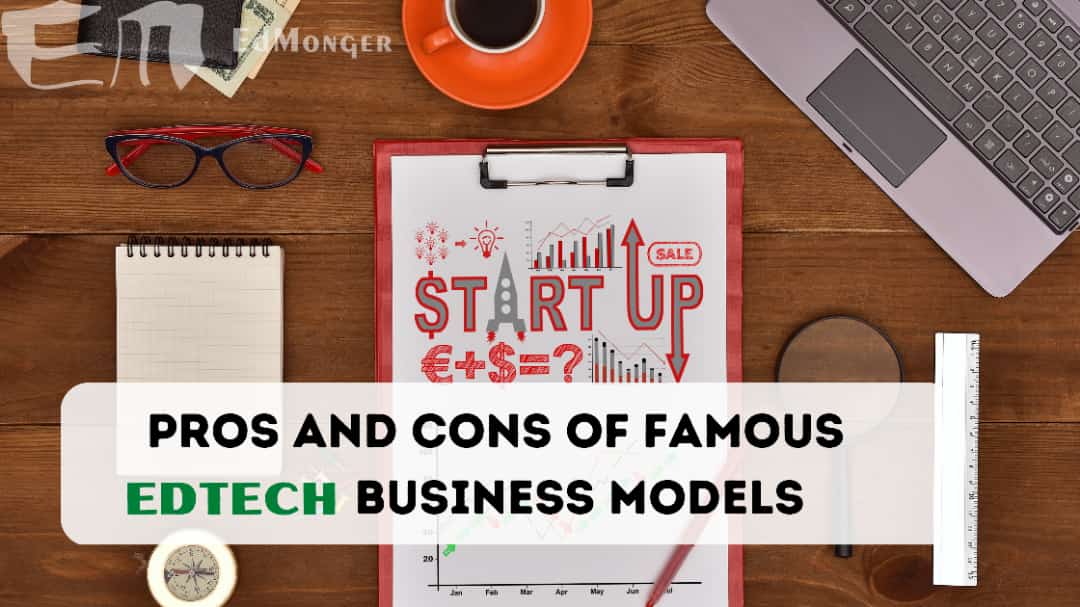There is no doubt that technology has had a profound impact on Education. And according to stats, in the last five years, the edtech business has had the highest share of startups across all sectors, which implies more and more players are entering the market with various edtech business models.
It will not be an innovative idea that will work alone. Rather a sustainable model is the key to profit-making. However, the question of which edtech business model is best remains debated.
Some argue that the best model is based on freemium pricing, while others maintain that a subscription-based model is more effective. Still, others believe that a model based on advertising is the best option.
Well, this and be understood only if you know the detailed pros and cons of all the models and find out what works the best for your edtech startup idea. Let’s explore some companies using these models and find out what has served them fairly well.
Freemium
Companies following the Freemium model: Coursera, BYJU’s
Freemium is one of the advantageous models out of all the edtech business models. It’s more like you’re giving out a sample of your product/service and then charging for a special and premium one.
But why do many startups follow this model?
The answer is simple; it’s the most authentic way to gain customer loyalty and product virality. However, the freemium model has its risk involved in profit making. You must check out its pros and cons before choosing this model.
Pros
- The cheaper way to create Brand awareness
- Lesser marketing cost
- Easy way to find product market fit.
- Large database of users
Cons
- Added marketing cost to convert consumers to customers.
- Low conversion rate
- The return on investment (ROI) will take a long time
- May have some dead accounts, which will increase operational cost
How Freemium model can be executed better?
The Freemium model has been successful for many companies, but there’s a high chance model will burn a lot of money. So, to prevent freeloaders and find authentic users, a cheap plan can be released and charge a good amount for premium services.
cheap + premium= cheapium
Subscription-based model
Companies following the subscription model: Educative, Kutuki
The model is often confused with the freemium model, but the difference is that the entire range of services is offered for a short period for free then, to continue to use the services, the customer has to pay. By the trial’s end, most genuine consumers convert into customers.
The model is a fit for two categories: services and content delivery
Pros
- Customer retention – Customer retention is high as the subscriber gets something new with every subscription.
- Inventory and demand prediction
- User behaviour – let the business thrive as small/big changes can be done for sustainability and better performance.
Cons
- The subscription model is highly competitive – as this model prevents the burn of a business, this model is highly competitive.
- High customer acquisition and marketing costs
- Overwhelmed customers -with many subscriptions for so many products and services, the customer may leave unnecessary subscriptions.
- Slow brand awareness
How Subscription model can be executed better?
The subscription model works better if customers frequently have new content/add-on services, which is more engaging and compels the users to keep returning.
Customers often discontinue the subscription if the product is not worth the money. To keep it more lucrative company can focus more on brand management. Running various campaigns and educating through webinars, meetups, offers, freebies, and many other small things will keep the consumer’s interest intact.
Sponsored Model
Companies following sponsored model: GoNoodle, iDream Education
According to STATISTA, revenue from standard advertisement and the sponsored business model segment is projected to reach US $0.89 bn in 2023. This one is not very famous out of all the edtech business models but is often used by edtech companies where neither the parents nor the schools have to pay. Still, companies looking to promote their products or services spend to reach the right audience, like, students and educators.
This allows them to gain valuable insights into the education market. These activities are done under corporate social responsibility. Sometimes if the idea is to help the masses and scale to a grant from the government can be given too.
Pros
- It is a great way to build trust amongst the audience once a name of a big company or grant is involved
- It becomes easy to reach out to the masses
- Work better as a side revenue stream
- The coalitions are strong
Cons
- It’s not easy to get funded by companies or get a grant.
- Hard to depend solely on this business model as revenue streams will be lower.
- Have to rely on an additional business model for scaling.
How a Sponsored model can be executed better?
Not relying completely on grants can make it easier to deal with revenue streams. Since it has become a network-heavy model, advertisements can be included in this.
Also Read: What are the different types of education technology?
Edtech Marketplace Model
Companies following the edtech marketplace model: Udemy, Wiz IQ
An Edtech marketplace business model is a similar stock market place which typically involves creating a platform that connects educators, trainers, and students with edtech solutions, courses, and content.
This can either be a B2B or B2C, where educators and trainers can offer their courses and solutions, and students can discover and enrol in the courses they need.
The revenue generation is through commissions on course sales, subscription fees, and advertisements. The vision is to provide a convenient and effective solution for all stakeholders involved in the education segment and revenue generation.
Pros
- The low-risk model will give returns without many losses
- Don’t have to invest too much in creating the resources
Cons
- Lower margins
- Building customer trust will in a third party takes time and added effort.
- The user interface has to be seamless.
How Edtech marketplace model can be executed better?
This model is gold if the consumer pays less for a course and the creator gets a bigger commission.
And this is possible if the model scales up quickly, with more users, more creators, and a heavy network hence scaling, and chances of losses to events of profits become small.
Top-down Model
Companies following the top-down model: Schoolzilla, Simplilearn
The top-down model, often known as the institutional model, where companies target educational institutions, such as schools and districts, in the case of (Simplilearn, the target is the companies) as their primary customers, offering a wide range of technology-based products and services designed to support the teaching and learning process. These companies provide professional development and support services to help educators integrate technology effectively into their teaching practices.
Pros
- Big revenue generation with fewer deals
- Strong partnerships
- Post sales revenues
Cons
- Lack of flexibility and customization in technology use
- Difficulties in adapting to the unique needs and preferences of individual educators and students
How Top-down model can be executed better?
This model benefits more if a regular assessment of the impact of technology is done. It can be done by collecting data, regular surveys, some site visits, and many more. This can create a more significant impact if regular professional development workshops are conducted to educate and empower the users with technology loopholes.
Bottom-up Model
Companies following bottom-up model: Scholastic, ABC mouse
The bottom-up business model is a consumer-centric model which generates revenue when a consumer sees the result. This is one of the favoured edtech business models as it works for B2C but involves B2B operations. The school/college gets a free product and promotes it to the students, and parents pay to use it if they like.
Pros
- It gives more flexibility in terms of customization
- Customer loyalty has been for a long time
- Better alignment of the product according to real needs
Cons
- Customer acquisition is a long process
- Increased operational cost
- Increased complexity when post-service help will be required
How bottom-up model can be executed better?
Deeper research and development with the help of some users at an early stage can help create a smooth product. In a business model like these standardisations of the processes is a must.
Conclusion
The ability of the business to serve the demands of its target market and produce income sustainably ultimately determines the success of a business model.
Edtech entrepreneurs can choose the ideal strategy for their firm by comprehending the various edtech business models and considering elements like target market, rivalry, and scalability. According to us considering the cons of any model a variation should be done in an existing model.
It can be either amending two models or executing it in a way where there win-win situation.
If you’re an edtech entrepreneur do comment on which model has favoured the most to your business.




